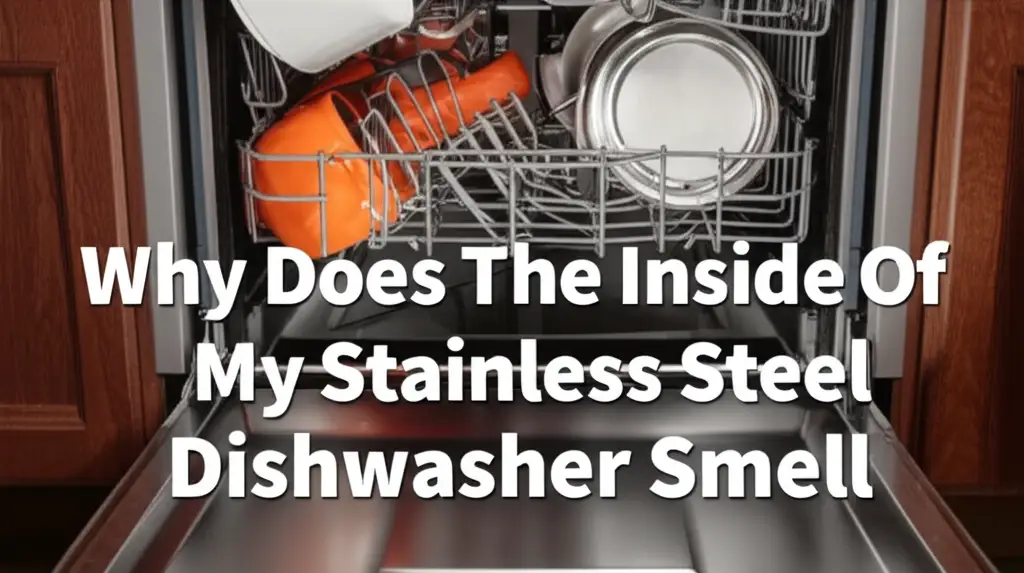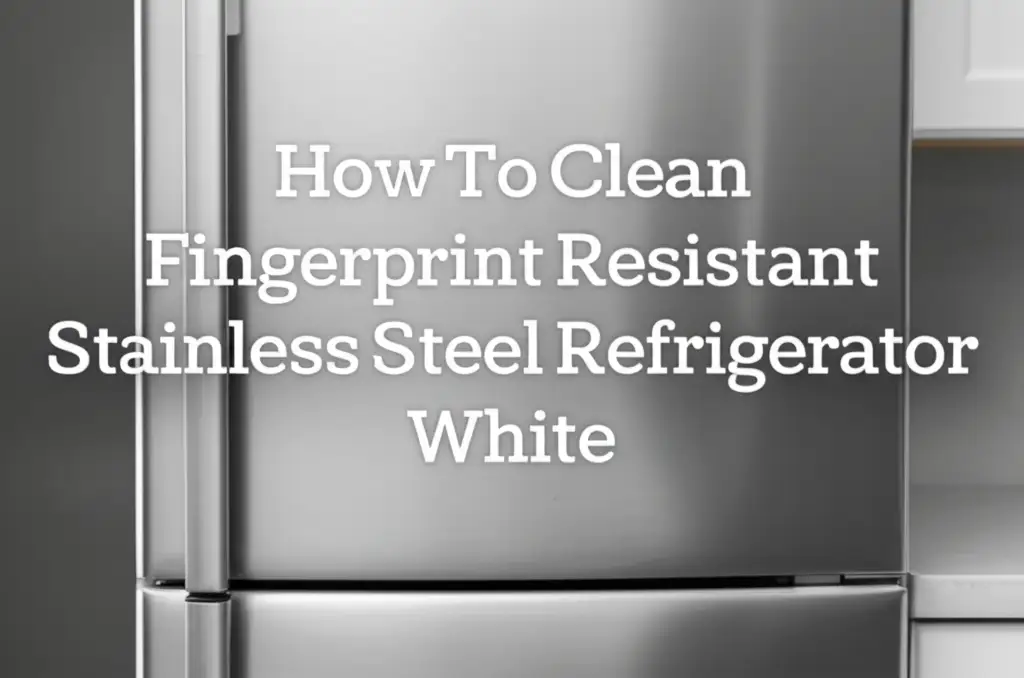· Davia Murnell · Appliance Care · 15 min read
Why Does The Inside Of My Stainless Steel Dishwasher Smell

Why Your Stainless Steel Dishwasher Smells: Solutions
Imagine opening your dishwasher, expecting clean dishes, but a foul odor hits you instead. This is a common and frustrating problem for many homeowners. A bad smell inside your stainless steel dishwasher can ruin the freshness of your kitchen. It also makes you question how clean your dishes truly are.
Understanding why your stainless steel dishwasher smells is the first step toward a solution. The good news is most causes are simple to fix. We will explore the main reasons behind that unpleasant smell. We will also provide clear steps to eliminate it. This guide helps you maintain a fresh, clean appliance.
Takeaway
- Clean the Filter: Remove and wash your dishwasher filter regularly.
- Inspect the Drain: Ensure no food blocks the drain area.
- Check Spray Arms: Clear any clogged holes on the spray arms.
- Use Proper Detergent: Do not use too much or too little detergent.
- Run Cleaning Cycles: Use vinegar or baking soda to sanitize the dishwasher.
- Maintain Gaskets: Wipe down door gaskets often to prevent mold.
- Run Hot Water: Flush the garbage disposal before running the dishwasher.
A stainless steel dishwasher smells bad due to trapped food particles, mold or mildew growth, hard water deposits, or drainage issues. These problems often create a damp environment where bacteria thrive, leading to unpleasant odors. Regular cleaning and proper maintenance prevent these smells.
Food Particle Accumulation: A Primary Cause
One of the most common reasons your stainless steel dishwasher smells is the buildup of food particles. Despite its powerful jets, your dishwasher does not always wash away every bit of food debris. Over time, these small scraps collect in various parts of the machine. They start to decompose, creating a rotten smell.
The dishwasher filter is a prime spot for food collection. Many modern dishwashers have a removable filter at the bottom. This filter traps larger food bits to prevent them from clogging the drain pump. If you do not clean this filter regularly, it becomes a breeding ground for bacteria and mold. The smell can become quite strong.
Spray arms can also harbor food particles. The small holes on the spray arms direct water onto your dishes. Sometimes, tiny food pieces or mineral deposits clog these holes. This reduces cleaning effectiveness and allows organic matter to accumulate. This buildup contributes to the overall odor.
The drain area itself can hold residual food. Even after a cycle, some water and tiny food particles may remain in the sump area. If this stagnant water sits for long periods, or if the drain line has blockages, it can produce a foul smell. Pre-rinsing dishes helps, but regular maintenance is still key. Cleaning these components regularly is essential to prevent these odors. You can learn more about deep cleaning your appliance by checking our guide on how to clean the inside of a dishwasher.
To address food particle accumulation, start by checking your filter. Remove it and rinse it under running water. Use a soft brush to scrub away stubborn debris. Then, inspect the spray arms for any blockages and clear them. Finally, ensure your drain is clear and functioning properly. For a thorough clean, follow specific steps on how to clean stainless steel dishwasher.
Mold and Mildew Growth: Damp Environment Issues
Mold and mildew thrive in damp, dark environments. Your stainless steel dishwasher, with its moist interior after each cycle, offers an ideal breeding ground. If the dishwasher does not dry completely between uses, or if water is left standing, mold spores can quickly multiply. This leads to a musty, earthy smell.
The door gasket is a common place for mold to grow. The rubber seal around the dishwasher door traps moisture and food residue. It forms a perfect habitat for mildew. Over time, this buildup can become black or pinkish. It will release a very strong, unpleasant odor.
Inside the tub, especially in crevices or corners, mold can also form. This happens if cycles are not hot enough to sanitize the interior fully. It also occurs if the dishwasher is not run frequently. The stainless steel itself is resistant to mold. However, the organic material that collects on it is not.
Mold growth indicates a need for better ventilation and regular cleaning. After each cycle, leave the dishwasher door ajar for a while. This allows air to circulate and the interior to dry completely. This simple habit makes a big difference in preventing mold. You should also regularly wipe down the interior.
To combat existing mold, you need to sanitize the dishwasher. Running a hot cycle with a strong cleaner, like vinegar or bleach (used separately, never together), can kill mold spores. Focus on scrubbing the door gasket thoroughly. This prevents future growth. Maintaining a dry environment is your best defense against mold and mildew smells.
Hard Water and Mineral Deposits: Limescale Buildup
Hard water is another common culprit behind a smelly stainless steel dishwasher. Hard water contains high levels of minerals, like calcium and magnesium. When this water dries, these minerals leave behind white or chalky deposits. This is also known as limescale. These deposits can accumulate inside your dishwasher.
Limescale builds up on heating elements, spray arms, and the interior walls of the tub. This buildup not only looks unsightly but also traps soap scum and food particles. This trapped organic matter then starts to rot. It produces a distinct, stale, or fishy smell. The mineral deposits also make your dishwasher less efficient at cleaning.
Soap scum also combines with hard water. Detergent does not rinse away completely in hard water. It leaves behind a sticky residue. This residue clings to the interior surfaces. It also creates a film that traps odors and encourages bacterial growth. This problem is worse if you use too much detergent or the wrong type for your water hardness.
The heating element can be particularly affected. As water evaporates during the drying cycle, minerals crystallize on the element. This reduces its ability to dry dishes properly. It also leaves moisture behind, promoting further odors. Over time, a thick layer of limescale can even cause the element to fail.
To address hard water deposits, use a descaling agent or white vinegar. Run an empty cycle with two cups of white vinegar placed in a bowl on the bottom rack. This acidic solution dissolves mineral buildup. Regular use of a rinse aid also helps. Rinse aid prevents water spots and helps the dishwasher dry more effectively. If you have severe stains, learning how to remove stains from stainless steel dishwasher can also help.
Drainage System Issues: Blockages and Backflow
Problems with your dishwasher’s drainage system can cause significant odors. If water cannot drain properly, it sits at the bottom of the tub. Stagnant water quickly becomes a breeding ground for bacteria. This leads to a very foul, rotten egg-like smell. Several components of the drainage system can cause this issue.
The drain hose connects your dishwasher to your home’s plumbing. This hose can become kinked, clogged with food debris, or even develop mold inside. If the hose is partially blocked, water drains slowly. It leaves behind a residue that smells bad. A complete blockage causes water to stand in the tub.
Many dishwashers connect to the garbage disposal. If your garbage disposal is not cleared before running the dishwasher, food waste can back up into the dishwasher drain. This is a common cause of sudden, strong odors. The disposal unit itself can also contain rotting food. This sends bad smells into the dishwasher through the shared drain line.
An air gap, if your local plumbing codes require one, can also be a source of problems. The air gap prevents dirty drain water from flowing back into your clean water supply. If the air gap gets clogged, it can impede proper drainage. This causes water to back up and creates odors. Inspecting and cleaning the air gap is important.
To troubleshoot drainage issues, first, check your garbage disposal. Run it for about 30 seconds with cold water before starting the dishwasher cycle. Then, inspect the drain hose for kinks or blockages. If you suspect a clog, you may need to disconnect and clean the hose. You may also need to check the air gap for debris. Understanding general dishwasher issues, such as those that make your GE dishwasher smell, can provide a broader context for common appliance problems.
Improper Detergent Use and Rinse Aid Deficiency
The way you use detergent and rinse aid significantly impacts your dishwasher’s cleanliness and smell. Using the wrong amount or type of detergent can lead to problems. It can leave behind residue or fail to clean dishes properly. Both scenarios contribute to unpleasant odors in your stainless steel dishwasher.
Using too little detergent means your dishes and the dishwasher interior do not get clean enough. Food particles and grease remain. They accumulate over time and begin to smell. The water may not be hot enough or the cycle long enough to compensate for insufficient soap. This results in dirty dishes and a dirty appliance.
On the other hand, using too much detergent also causes issues. Excess suds can leave a sticky residue on the dishwasher’s interior. This residue traps food particles and moisture. It forms a film that encourages bacterial growth. The film also coats the stainless steel, reducing its shine and attracting odors. The residue can clog spray arms and filters, making the problem worse.
The type of detergent matters too. Some inexpensive detergents may not break down food effectively or may contain fillers that leave residue. Opt for high-quality dishwasher detergents. These detergents are designed to clean thoroughly without excessive suds or residue. Pods or tablets are often convenient and ensure proper dosage.
Rinse aid is crucial for proper drying and preventing residue. Hard water can cause water spots and mineral buildup. Rinse aid breaks down the surface tension of water. This allows water to sheet off dishes and the dishwasher interior more effectively. Without rinse aid, water droplets dry on surfaces. They leave behind mineral deposits and moisture that contribute to odors. Make sure your rinse aid dispenser is full. Use a quality product for optimal results. Properly maintaining your dishwasher involves understanding how to effectively clean its interior to prevent these issues, as detailed in guides like how to clean the inside of a dishwasher.
Infrequent Use and Standing Water: Stagnation Risks
If you do not use your stainless steel dishwasher regularly, it can develop a musty smell. This is primarily due to standing water and a lack of proper circulation. Even if your dishwasher drains completely after a cycle, tiny amounts of water can remain in the sump or the drain hose.
When the dishwasher sits unused for extended periods, this residual water becomes stagnant. It allows bacteria and mold to grow without interruption. The warm, dark environment inside the appliance provides ideal conditions for these microorganisms to thrive. The longer the water sits, the stronger the unpleasant odor becomes.
Lack of regular use also means the dishwasher is not being flushed out. Regular cycles, especially hot ones, help to rinse away any lingering food particles or detergent residue. They also help to circulate fresh water through the system. Without this flushing action, contaminants simply sit and decompose.
To prevent smells from infrequent use, run your dishwasher at least once a week. Even if you do not have a full load of dishes, run a rinse-only cycle or a short wash cycle. This keeps water flowing through the system. It helps to clear out any potential odor sources.
Another tip is to leave the dishwasher door slightly ajar after a cycle. This allows air to circulate inside the tub. It helps the interior dry completely. This simple step prevents moisture buildup and inhibits mold and mildew growth. Even when not in use, a little ventilation can go a long way in keeping your dishwasher fresh. Consistent cleaning of your stainless steel dishwasher helps mitigate issues from infrequent use.
Dishwasher Component Inspection: Gaskets, Spray Arms, Sump
Regular inspection of your dishwasher’s key components is vital for preventing odors. While general cleaning helps, specific parts often harbor hidden grime and require closer attention. Neglecting these areas allows odors to build up, making your stainless steel dishwasher smell bad.
The door gasket, or seal, is a prime offender. This rubber seal runs around the perimeter of the dishwasher door. It prevents water from leaking out during a cycle. However, it also traps food particles, grease, and moisture. Over time, black mold or mildew can grow here. Wipe the gasket down with a damp cloth and mild cleaner regularly. Pull back the folds of the gasket to clean hidden areas.
Spray arms are another critical component to check. These rotating arms have small nozzles that spray water onto your dishes. Food debris, mineral deposits, or even small broken glass pieces can clog these nozzles. When clogged, water flow is reduced. This results in poor cleaning performance. It also allows organic matter to accumulate inside the arms, leading to odors. Most spray arms detach easily. Use a toothpick or small wire to clear out any blockages in the holes.
The sump area is at the bottom of your dishwasher tub, beneath the lower spray arm and filter. This is where water collects before draining. Food particles, grease, and even small bones can bypass the filter and settle in the sump. This area can become very foul-smelling if not cleaned. You may need to remove the filter and visually inspect the sump. Use a sponge or paper towel to wipe out any visible debris or standing water.
The heating element, often visible at the bottom of the tub, can also accumulate deposits. Limescale and burnt-on food can cling to this element. This causes a burnt smell or a stale odor. While you cannot scrub the element directly, regular descaling cycles (e.g., with vinegar) help keep it clean. Regular inspection and targeted cleaning of these specific components ensure a clean, odor-free stainless steel dishwasher. This deep cleaning helps prevent the issues that make you wonder how to clean stainless steel components effectively.
FAQ Section
Q1: How often should I clean my stainless steel dishwasher to prevent odors? A1: You should perform a quick clean, like wiping the filter and gasket, weekly. A deeper cleaning cycle, using vinegar or baking soda, should be done monthly. This routine helps prevent food buildup, mold, and mineral deposits from causing smells. Consistency is key for a fresh-smelling appliance.
Q2: Can the type of detergent affect my dishwasher’s smell? A2: Yes, the type and amount of detergent affect smells. Using too little detergent leaves food and grime behind. Using too much can create excessive suds and residue. This residue traps odors. Always use high-quality dishwasher detergent, and follow the manufacturer’s dosage recommendations for best results.
Q3: Is it safe to use bleach in my stainless steel dishwasher to remove odors? A3: Using bleach can kill mold and bacteria. It should be used with caution. Never mix bleach with other cleaners like vinegar, as it creates dangerous fumes. Run an empty hot water cycle with a small amount of bleach. Ensure you flush it completely. Also, bleach can potentially stain or damage some internal components over time.
Q4: My dishwasher smells like rotten eggs, what does that mean? A4: A rotten egg smell often indicates a sulfur-producing bacteria problem. This usually comes from stagnant water in the drain hose or sump. It can also point to issues with your garbage disposal if it’s connected. Clear any drain blockages and run a hot cycle with a dishwasher cleaner.
Q5: Will pre-rinsing dishes prevent my dishwasher from smelling? A5: Pre-rinsing dishes helps reduce large food particles entering the dishwasher, which can minimize some odors. However, it does not eliminate the need for regular cleaning of the dishwasher itself. Small food bits, grease, and detergent residue can still build up and cause smells over time, even with pre-rinsing.
Q6: Why does my new stainless steel dishwasher smell? A6: A new stainless steel dishwasher might have a slight plastic or chemical smell initially. This usually fades after a few uses. If it smells bad, check for shipping materials or residual manufacturing odors. Also, ensure proper installation, especially the drain connection, as a faulty setup can cause immediate odor issues.
Conclusion
A bad smell inside your stainless steel dishwasher is a common household problem. However, it is one you can fix with the right approach. We have explored the main reasons behind these odors. These include lingering food particles, mold growth, hard water buildup, and drainage issues. Each cause contributes to a less-than-fresh appliance.
Regular maintenance and cleaning are your best defense against a smelly dishwasher. This includes routine checks of your filter, spray arms, and door gaskets. It also involves using the correct detergent and ensuring proper drainage. By addressing these key areas, you maintain a clean and efficient dishwasher.
Do not let a foul smell take over your kitchen. Take action today. Implement the cleaning tips and troubleshooting steps we discussed. A clean dishwasher means cleaner dishes and a fresher home environment. Enjoy the satisfaction of opening a dishwasher that smells clean and fresh every time.
- dishwasher smell
- stainless steel dishwasher
- dishwasher cleaning
- odor removal
- appliance maintenance
- kitchen cleaning




